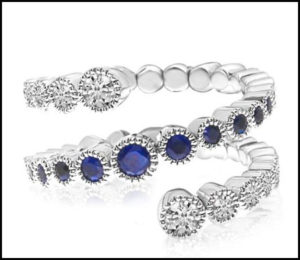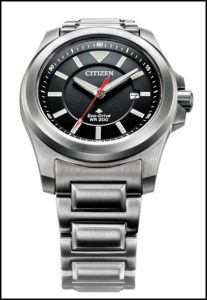Outlook Positive For Jewelry
Optimism is high in the jewelry business into 2019, finds JCK’s first State of the Industry Jewelry Report, shared during JCK Las Vegas in June. Some 88 percent of more than 500 jewelry professionals surveyed, mostly retail jewelers, and some wholesalers, manufacturers and designers are optimistic about the current state and near future of the jewelry business.
 Some 57 percent are feeling good about the general economy, with 46 percent considering it better now than a year ago, and over 40 percent forecasting better conditions a year from now, according to the report.
Some 57 percent are feeling good about the general economy, with 46 percent considering it better now than a year ago, and over 40 percent forecasting better conditions a year from now, according to the report.
Perhaps the biggest worry, for 47 percent of respondents, is online competition. Not quite half, at 46 percent of jewelers sell product on their store’s websites, with nearly 60 percent reporting e-commerce to be less than 25 percent of their business intake, although 55 percent say e-commerce has increased their business. More than 80 percent consider social media marketing to be a top business practice, and 90 percent plan to increase efforts.
Meet Expectations
Consumers today shop, browse and price check in store and online in whatever ways suit their needs at any given time and jewelers must embrace and encourage that reality to succeed, advocates Jay Gerber for the diamond jewelry manufacturer, WR Cobb, East Providence, Rhode Island.
Jewelers must provide the functionality to meet consumer expectations, says Gerber. On the website it’s about  convenience, the ability to compare and contrast, and also read feedback and reviews. In store, the ability to touch and try on, personal service and education is key. Both platforms offer opportunities to provide impressive visual experiences. He advocates jewelers partner with third party vendors that can integrate technology to expand categories and product offerings, as well as opportunities for custom work and personalization.
convenience, the ability to compare and contrast, and also read feedback and reviews. In store, the ability to touch and try on, personal service and education is key. Both platforms offer opportunities to provide impressive visual experiences. He advocates jewelers partner with third party vendors that can integrate technology to expand categories and product offerings, as well as opportunities for custom work and personalization.
It’s critical for jewelers to make investments in technology to move the needle forward for their business, says Gerber, who advocates retailers fast the healthy parts of their organization to energize areas rapidly changing with technology.
“Customers expect convenience, ease and personalization, and technology that can deliver that will be important to physical store success,” said author and renowned consumer futurist, Doug Stephens, AKA “The Retail Prophet”, to jewelers attending a Plumb Club symposium at JCK Las Vegas in June.
Invest in Technology
Sharing findings from his book, “Reengineering Retail: The Future of Selling in a Post-Digital World”, Stephens cited technologies that enable more personalized solution selling, targeted and localized inventory decisions, streamlined checkout processes, mobile-integrated experiences and overall ease of any time, anywhere purchasing as moving retail toward a true omni channel experience.
 Gerber cautions jewelers to not work against their own best interest, encouraging they merge advocacy of in store and online platforms. Some jewelers give sales associates less commission for sales they close online versus in store. Others have prices on products sold online for less than in store. “These two platforms are not in competition. Make the sale however consumers want to buy!”
Gerber cautions jewelers to not work against their own best interest, encouraging they merge advocacy of in store and online platforms. Some jewelers give sales associates less commission for sales they close online versus in store. Others have prices on products sold online for less than in store. “These two platforms are not in competition. Make the sale however consumers want to buy!”
Look to companies like Apple, Samsung, Disney and Starbucks as examples of retailers doing a good job of using technology and merging the in store and online experiences to engage, inform and connect, says Gerber. He advocates jewelers set/get acceptance of their team to adopt the mindset of promoting all channels consumers browse and shop. And, for jewelers to surround themselves with the right talent, reflective of the audience they want to reach.
Add-on experiences like custom design, private buying rooms and interactive displays elevate the shopping experience and make the store standout in consumers’ minds, advocates Jordan Peck, owner of TracTech Systems in New York, which provides RFID solutions to the jewelry industry, a company that originated for his family’s manufacturing business, Color Merchants of New York.
Technologies that improve the customer experience on the front end include solutions that more effectively manage the backend to drive sales, says Peck. “Data analytics helps retailers understand the trends of their clients and staff to keep inventory turning. Having the ability to breakdown inventory by popular products versus items sitting goes a long way. It allows retailers to allocate employee time more efficiently, and provides the information needed to effectively market products and trends to consumers.”
Importance of Branding As more purchasing decisions are made or influenced online, branding is crucial to  differentiate and motivate sales, says Susan Chandler, chief merchandising officer for Bulova in New York. “In today’s rapidly shifting retail environment, faced with a new generation of consumers, it’s more vital than ever to build and drive brand identity. The key is to make an emotional connection with consumers and maximize engagement. Branding also highlights product attributes, ensuring consumers understand the benefits the brand delivers.”
differentiate and motivate sales, says Susan Chandler, chief merchandising officer for Bulova in New York. “In today’s rapidly shifting retail environment, faced with a new generation of consumers, it’s more vital than ever to build and drive brand identity. The key is to make an emotional connection with consumers and maximize engagement. Branding also highlights product attributes, ensuring consumers understand the benefits the brand delivers.”
Amy Fisher, senior vice president of marketing for Citizen Watch, New York advocates that through consistent brand messaging and understanding of consumers, retailers can offer products they want and experiences that keep them engaged. Citizen, she says, partners with real people to share stories aligned with its core values and brand DNA, like polar explorer, Eric Larsen, who has taken several watches on expedition. Honora, a Richline Group brand, too, uses real women wearing pearls in its lifestyle photography—encouraging them to find their luster.
We live in a world that requires labels for consumer understanding of why a product is right, says Mark Hanna, Chief Marketing Officer of the NYC-based Richline Group. “A brand is that label defining everything from style-right, to quality-correct, to responsibly-sourced to emotionally pleasing. The impact of social selling is immense and requires brands. Our strategy is to create national brands with clear consumer perceptions and multi-retailer availability.”Newsletter
 Part of successful brand partnerships includes marketing support to help jewelers sell through, and Allison Peck for Color Merchants and its Brevani brand says jewelers appreciate regularly sharing social media content to keep content fresh, exciting, seasonal and representative of how the brand wants to be perceived.”
Part of successful brand partnerships includes marketing support to help jewelers sell through, and Allison Peck for Color Merchants and its Brevani brand says jewelers appreciate regularly sharing social media content to keep content fresh, exciting, seasonal and representative of how the brand wants to be perceived.”
Customized and meaningfully real experiences resonate with consumers, emphasizes Nathan Button, product manager for the display and packaging division at Rio Grande, a Richline brand based in Albuquerque, New Mexico. “Displays instantly present your products, setting forward that initial perception of your brand. And that perception needs to carry through as it leaves the store in the packaging.”